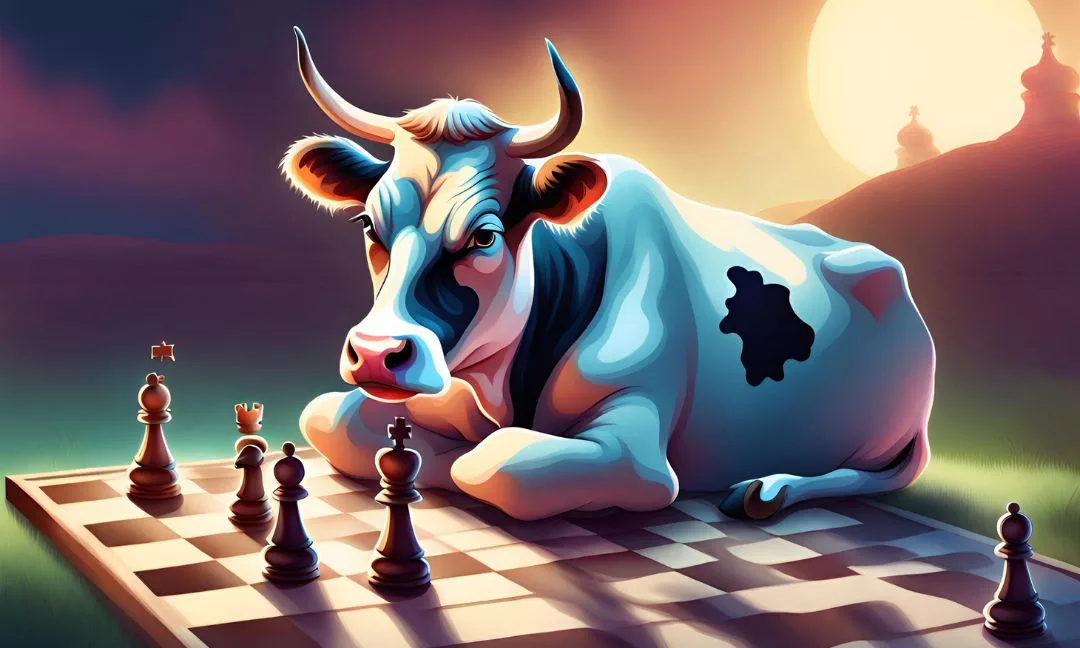What’s the deal with everyone discussing the Cow Opening? This article will delve into its origins, its creator, and how to employ it effectively.
In the expansive world of chess, where centuries of strategies have been carefully documented, finding something new can feel daunting. However, amidst the complex array of openings and defenses, a fresh idea has emerged: the Cow Opening.
The Cow Opening was made famous by WFM Anna Cramling. Whether she truly invented it is up for debate. Nevertheless, her frequent use of the opening has encouraged many IMs and GMs to give it a try as well.
The Cow is all about uniqueness and adaptability. Starting with simple moves like e3 and d3, it slowly builds up, placing knights on g3 and b3. It’s useful with both white and black pieces.
What sets the Cow Opening apart is its ability to disrupt opponent’s pawn structure with moves like c4 or f4.. Anna describes this as a means to “milk the position”. “You try to find small inaccuracies and what your opponent is doing or big blenders or whatever it doesn’t matter. And you try to win the middlegame and endgame. Even if the opening doesn’t get you an advantage it puts you in a position where the opponent doesn’t really know what they’re doing either and sometimes they’ll spend a lot of time”, she said.
Some may question the Cow Opening’s immediate benefits, as chess engines might not immediately see its value. But Anna argues that its true strength lies in its psychological impact on opponents. By taking them out of their comfort zone, players can use their discomfort to their advantage. “It’s a very playable position and let me tell you something, if you are under 1600, the opening that you play matters zero”.
In fact, Anna said that she’s had a 50% win rate with this opening, but the games that she lost have not been because of the opening it’s mostly been because she’s blundered later on. She had a pretty decent result with this opening even at her level at 2100.
In this typical position after the sixth move, White played the Cow Opening. According to the database, Black holds a 52% chance of winning compared to White’s 46%. However, executing the Cow Opening requires less time for White, as its moves are straightforward. This opening proves particularly effective in faster time controls without increments. Below is an example of a game where White employed the Cow Opening and secured victory by checkmate.
So why’s the cow? It is Chess Openings Wizard? No. It’s actually the cow, the livestock. So why Anna named it the cow opening? Because she said she loved cows. And, “because this opening has everything that a cow has”.
“When I was thinking about cows, I was thinking and I wanted to create it, to call it the cow opening, because my profile picture on chess.com is a cow. And the reason I have this profile picture is because I made a bet with myself that I would have it until I reached 2300 rating. So it’s gonna be a little while and you know me and the cow has had to become friends, so I knew that I had to call it the cow opening”.
WFM Anna Cramling
She draws inspiration from the story of Ferdinand the bull to craft an opening that seems harmless at first glance but holds concealed power, comparing it to rousing an inner beast within the player.
IM Eric Rosen used to play the Cow Opening for an entire Titled Tuesday event. Despite his initial complaints about the poor positions he found himself in, he managed to achieve a decent score, even surpassing his usual standards.
However, if you play the Cow against someone who is significantly higher rated than you, it might not be a wise choice. You could end up getting crushed, as was the case when GM Hikaru Nakamura faced the inventor Anna. Hikaru even said that the opening wasn’t new, as he had seen some players employ it back in the 90s.
Regardless, the Cow Opening could be considered a new opening because Anna popularized it. It’s a fun and potentially surprising choice that can catch opponents off guard. I would recommend players below 2400 rating to consider playing this opening. As GM Loek van Wely used to say, “Don’t seriously study many openings until you’re 2400.” The Cow Opening isn’t about theory; it’s about adaptability, calculation, and resourcefulness. And that’s what chess is about.
How to Defend Against the Cow Opening
Now, what if you encounter someone playing the Cow Opening against you? If you’re in the mood for some fun, you can play the Cow Opening back at them. But if you’re serious about winning, thinking, ‘How dare you use my favorite opening against me!’, you should aim to counter it effectively by pushing your a and h pawns.
For instance, as White, push a2-a4-a5 and h2-h4-h5 to kick your opponent’s knights from b6 and g6. The knights will be forced to retreat to d7 and e7, taking away space that would otherwise belong to their bishops.
‘Basically, if someone knows to play a4 and h4 against the Cow Opening, it’s absolutely terrible for you. You’d get smoked,’ Hikaru said.
*If you want to try another weird opening, check out Alien Gambit: The Hottest Trend in Chess.

I’m Xuan Binh, the founder of Attacking Chess, and the Deputy Head of Communications at the Vietnam Chess Federation (VCF). My chess.com and lichess rating is above 2300, in both blitz and bullet.

